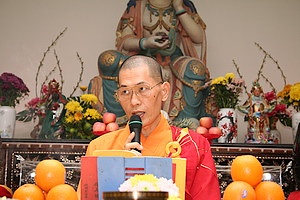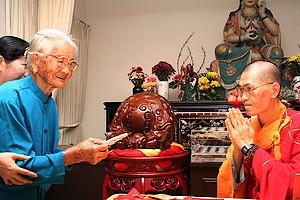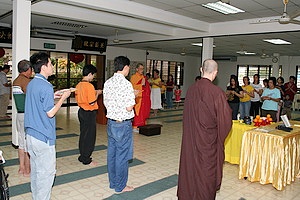Submitted by Ah Jin on

In commemoration of the enlightenment day of the Bodhisattva Avalosteswara which fell on the 19th day of the sixth moon of the lunar calendar( 20th July 2008), a taking of Three Refuges and five precepts ceremony was held at the great compassion hall of Than Hsiang Temple. About twenty devotees took part in the ceremony.
The ceremony was precede by the chanting of sutra, a dharma talk by Ven. Zhen Ru and repentance in front of the Buddha statue before the refuges and five precepts taking ceremony.
Ven. Zhen Ru’s dharma talkwas based on Ven Wei Wu’s writing on “the commentary to the stages of the path” (of the Lamrin tradition by Tsongkhapa) and the “introduction to the taking of five precepts”.
Before we learn the dharma, we tend to seek help from the gods or devas. However, the deva realm is but one of “the six realms of existence or path of rebirth”. They stand in contrast to the higher attainments of the ten spiritual realms. The six realms are as follows: rebirth as a deva, an asura, a human being, an animal, a hungry ghost, a being in hell.
The materialists believe that when one dies, that is the end of everything. According to Buddhism, this is wrong view. In Buddhism, instead of seeking for external saviour, Buddhists believe they can take refuge in themselves. The taking of three refuges and five precepts form the basis of liberation. The three refuges in the three jewels refer to:
• The Buddha;
• The Dharma, the teaching;
• The Sangha - the monks and nuns community.
The three refuges will protect us from falling into the three lower realms of animal, hungry ghost and hell beings.
However, we should not allow ourselves to be trapped in the six paths of rebirth .We should, instead, try to seek liberation by following the teaching of the Buddha.
Only the Buddha possesses the power to
• Eliminate the six roots of defilements
• Liberate all sentient beings
• Radiate immeasurable compassion.
Thus, Buddha is one of the most reliable refuges to rely on for liberation. Other holy personalities in ascending order of importance the Buddhist tradition are the sravakas, the Paccheka Buddha, the bodhisattva and the Buddha. Therefore, the Buddha serves as the ideal or the highest aspiration any Buddhist should aim as a path for liberation.
The Dharma represents the discourses of the Buddha which were passed down orally by the immediate disciples until they were committed into writing five hundred years after Buddha’s parinirvana. Printing of Sutra took place in China after Buddhism spread to China.
The Sangha refers to the community of monks and nuns. Strictly speaking, taking of refuge in sangha means the enlightened Bhikkhus and Bikkhunis. The Sangha possess the merits but lack the perfection of a Buddha, who attained enlightenment by himself. Nevertheless, the sangha community, through their faith and devotion serve as our teachers and guides.
The five precepts are the basic Buddhist code of ethics, undertaken by all lay Buddhists.
The five precepts are:
• To abstain from killing ( representing the sanctity of human life)
• To abstain from stealing( taking any thing without the consent of the owner)
• To abstain from sexual misconduct( sexual relation outside matrimony)
• To abstain from lying ( false speech)
• To abstain from intoxication.( drinks and drugs)
The first three abstentions protect one from committing unwholesome karma arising from bodily actions, the fourth from committing verbal karmic repercussion and the last will enable one to be constantly mindful and alert from breaching any one of the five precepts.
At the end of the ceremony, all the participants undertaking the refuges and precepts taking ritual were present certificates by the preceptor.



